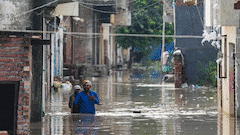Taj Mahal Barely Visible As Thick Fog Shrouds World Heritage Site
The UNESCO World Heritage site Taj Mahal vanished completely behind thick smog.

North India continues to reel under severe air pollution with many cities blanketed by smog affecting visibility. On Thursday, the UNESCO World Heritage site Taj Mahal vanished behind thick smog. A report by NDTV shows minimal visibility at the site as tourists walk towards the monument. The report highlights that the air quality index (AQI) in Agra stood at 193 in the 'moderate' category according to the Central Pollution of Control Board (CPCB) data.
According to the India Meteorological Department (IMD), very dense fog conditions are “very likely in many pockets of in a few pockets of West Uttar Pradesh and isolated pockets of East Uttar Pradesh”. Parts of the state are likely to see fog/mist over the next few days.
A report by India Today says that Agra’s Municipal Corporation is under scrutiny after a video showed water sprinklers installed on the roof of the Municipal Corporation building directly affecting the city's primary automatic air quality monitoring station. The report says that the sprinklers which have been installed over the past five days reduced AQI but did not impact the air pollution level in the area.
During an investigation by the Uttar Pradesh Pollution Control Board (UPPCB) team, it was found that the sprinklers were positioned to spray in the southwest direction while prevailing winds were blowing from the northwest to the southeast. This setup may have impacted the AQI reading giving improved readings. The report says that UPPCB’s Regional Officer Dr Vishwanath Sharma has ordered the removal of the sprinklers.
Meanwhile, Delhi continues to see "very poor" air quality with the city recording an AQI of 366, according to the CPCB. Surrounding areas of Delhi including Noida, Gurugram, Ambala, Rohtak, and Karnal also witnessed similar scenes with smog and fog engulfing these cities. The main reason for the smog has been attributed to the use of vehicles and stubble burning.
The Taj Mahal is located on the right bank of the Yamuna River and was built by Mughal Emperor Shah Jahan in memory of his wife Mumtaz Mahal with construction starting in 1632 AD and completed in 1648 AD. The Taj Mahal is the jewel of Indo-Islamic art and one of the universally admired masterpieces of the world's heritage





































